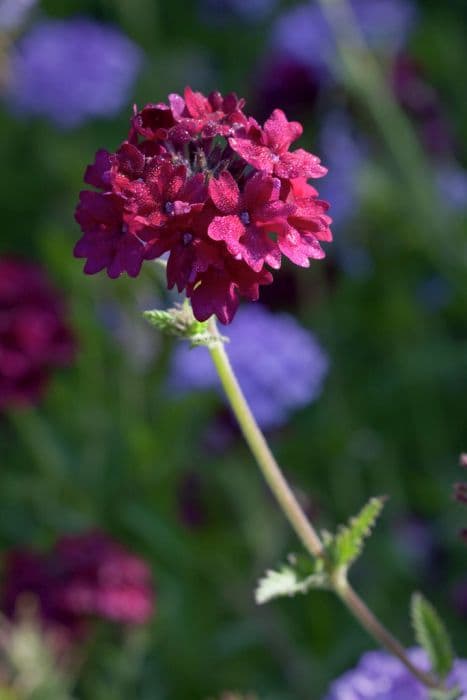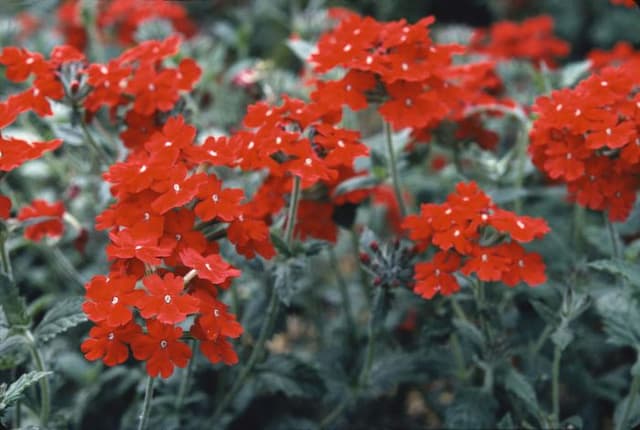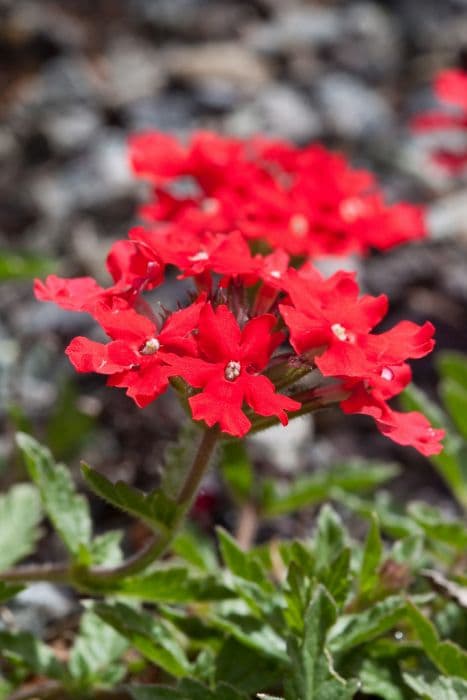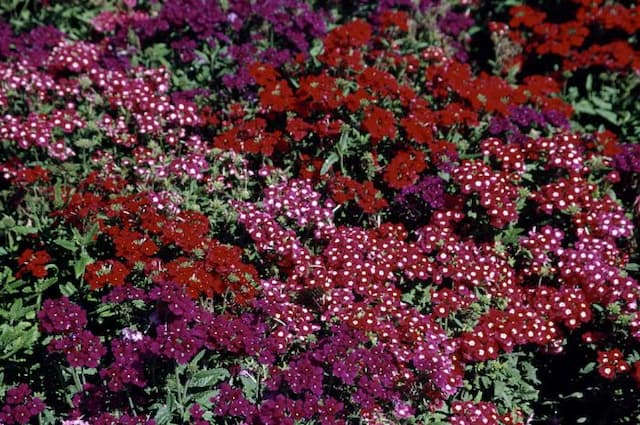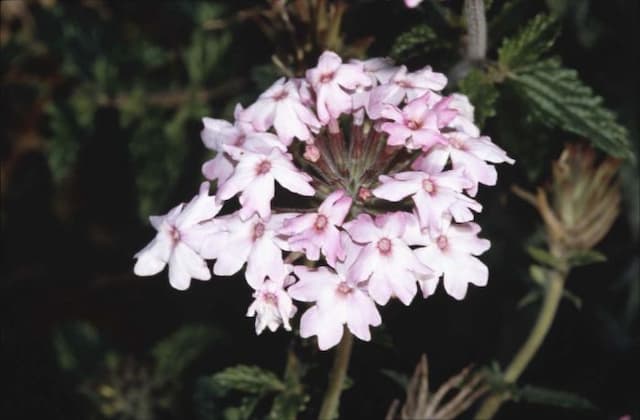Peruvian Mock Vervain Glandularia peruviana Endurascape Pink Bicolor = 'Balendpibi' (Endurascape Series)
![vervain [Endurascape Pink Bicolor]](/_next/image?url=https%3A%2F%2Fplants-admin.emdemapps.com%2Fimages%2Fplants%2F%2Fimages%2F604b594e749b0.png&w=3840&q=75)
ABOUT
The Glandularia peruviana Endurascape Pink Bicolor, commonly known as verbena, is a striking flowering perennial. It stands out for its vibrant blossoms which are characterized by a delightful bicolor pattern. Each flower displays a cheerful pink shade that seamlessly transitions into a creamy white towards the center, giving off a soft and enchanting contrast. The flowers are clustered at the tips of the stems, forming rounded, dense clusters that present a lively appearance. The foliage of the verbena is equally impressive, composed of small, oblong leaves that provide a lush green backdrop to the vivid blossoms. The leaves are often finely serrated along the edges, with a slightly textured surface that adds to the plant's visual interest. The blossoms and foliage combine to create a lush, mounding form that spills over gracefully, making it a favorite for adding a burst of color to gardens, hanging baskets, and containers alike. The plant exhibits a robust and bushy growth habit, contributing to its enduring appeal throughout the growing season.
About this plant
 Names
NamesFamily
Verbenaceae
Synonyms
Peruvian Mock Vervain, Peruvian Verbena, Endurascape Pink Bicolor Verbena
Common names
Verbena peruviana, Glandularia peruviana, Verbena patagonica, Glandularia patagonica, Verbena gooddingii, Glandularia gooddingii.
 Toxicity
ToxicityTo humans
Glandularia peruviana, commonly known as Peruvian verbena, is generally considered non-toxic to humans. There is no widespread documentation of toxic effects from ingesting this plant. However, as with any plant, individual sensitivities may vary and it is always advisable to avoid ingestion. If significant quantities are consumed and symptoms such as gastrointestinal discomfort, nausea, or allergic reactions occur, medical attention should be sought.
To pets
Peruvian verbena is not commonly listed as a toxic plant for pets, including cats and dogs. It is not typically associated with serious poisoning risks in household pets. However, it's best to keep an eye on your pets and ensure they don't ingest plants since different animals can have different sensitivities, and consuming non-food plants can sometimes lead to mild gastrointestinal upset or other symptoms in pets. If you notice any adverse reactions after your pet has ingested part of this plant, consult your veterinarian.
 Characteristics
CharacteristicsLife cycle
Perennials
Foliage type
Evergreen
Color of leaves
Green
Flower color
Pink Bicolor
Height
1 feet [30 cm]
Spread
2 feet [60 cm]
Plant type
Herb
Hardiness zones
8
Native area
South America
Benefits
 General Benefits
General Benefits- Drought Tolerance: Can survive with minimal watering once established, making it suitable for dry climates.
- Heat Resistance: Thrives in high temperatures, making it ideal for hot summer gardens.
- Long Blooming Period: Offers colorful flowers from early spring to frost, providing extended visual interest.
- Low Maintenance: Requires little care beyond occasional watering and deadheading, making it easy for gardeners of all levels.
- Versatility in Landscaping: Suitable for borders, containers, and as ground cover, offering various design possibilities.
- Attracts Pollinators: Flowers draw in bees, butterflies, and other pollinating insects, supporting biodiversity.
- Colorful Foliage: In addition to flowers, the foliage adds texture and color to the garden space.
- Deer Resistance: Generally not preferred by deer, reducing the likelihood of damage in gardens prone to deer visits.
- Winter Hardiness: Can survive cold temperatures up to USDA hardiness zone 8, providing a perennial option in many regions.
 Medical Properties
Medical PropertiesThis plant is not used for medical purposes.
 Air-purifying Qualities
Air-purifying QualitiesThis plant is not specifically known for air purifying qualities.
 Other Uses
Other Uses- As a natural dye: The vibrant pigments of the Glandularia peruviana flowers can be used for dyeing fabrics or other materials in craft projects.
- Educational tool: Its growth pattern and hardiness make it ideal for teaching students about plant adaptation and horticulture.
- Photography subject: Its picturesque form and bicolor blooms make it a popular subject for photographers and botanical artists.
- Ground cover for model landscapes: Miniature hobbyists use the dense growth of Glandularia peruviana for realistic ground cover in model dioramas or train sets.
- Culinary garnish: Though not widely known for culinary uses, its colorful blooms can aesthetically enhance food presentation.
- Scented sachets: The foliage, when dried, can be used to make scented sachets for drawers and closets.
- Herbal crafts: Leaves and flowers can be incorporated into wreaths, dried flower arrangements, or potpourri mixtures for their color and form.
- Insectary plant: It can serve as a living trap crop, distracting insect pests from more valuable plants in gardens or farms.
- Erosion control: Its ability to form dense mats makes it useful for stabilizing soil on slopes or areas prone to erosion.
- Green roof planting: Because of its drought tolerance and low maintenance, it's suitable for green or living roofs in appropriate climates.
Interesting Facts
 Feng Shui
Feng ShuiThe Verbena is not used in Feng Shui practice.
 Zodiac Sign Compitability
Zodiac Sign CompitabilityThe Verbena is not used in astrology practice.
 Plant Symbolism
Plant Symbolism- Endurance: Because 'Endurascape' is part of its name, this plant symbolizes the ability to endure harsh conditions and continue to thrive, reflecting resilience and perseverance.
- Transformation: Its vivid bicolor blooms suggest change and transformation, embodying the idea of embracing growth and new beginnings.
- Femininity: The pink color in the flowers is often associated with feminine qualities, symbolizing grace, gentility, and happiness.
- Bliss: The plant's vibrant and joyful appearance signifies bliss and represents the light-hearted side of life.
- Balance: As a bicolor plant, it visually portrays balance and unity of two different elements, suggesting harmony and coexistence.
 Water
WaterWater Verbena once the soil surface starts to dry out, typically once a week, although in very hot or windy conditions, you may need to water more frequently. Ensure water penetrates to the root zone by applying approximately one gallon per square foot every time you water. During cooler months or periods of rainfall, reduce watering. Overwatering or allowing the plants to sit in water can lead to root rot, so ensure proper drainage. Consistency in watering will promote healthy growth and flowering.
 Light
LightVerbena thrives in full sun, meaning it needs at least 6 to 8 hours of direct sunlight each day. It is best planted in a location where it will receive unfiltered sunlight for the majority of the day. While it can tolerate some partial shade, the flowering might not be as prolific without full sun exposure.
 Temperature
TemperatureVerbena prefers warmer temperatures and can handle a climate ranging from 60°F to 90°F. It should be protected from frosts and freezes, as it may not survive temperatures below 20°F. The ideal growing conditions for vibrant blooms and healthy foliage are between 70°F and 85°F.
 Pruning
PruningPrune Verbena to encourage bushier growth and more blooms, and to prevent it from becoming leggy. Deadheading, or the removal of spent flowers, should be done regularly to promote continuous flowering. The best time for significant pruning is in the early spring or after any danger of frost has passed.
 Cleaning
CleaningAs needed
 Soil
SoilVerbena requires well-draining soil with moderate fertility. A mix of peat, compost, and perlite or sand promotes good drainage. The ideal soil pH for Verbena, including the Endurascape Pink Bicolor, is slightly acidic to neutral, ranging from 6.0 to 7.0.
 Repotting
RepottingVerbena typically does not require frequent repotting. Endurascape Pink Bicolor should be repotted every 2-3 years or when it outgrows its current container.
 Humidity & Misting
Humidity & MistingEndurascape Pink Bicolor Verbena thrives in average humidity levels. Avoid excessively high humidity to prevent disease; ambient outdoor humidity is generally sufficient.
 Suitable locations
Suitable locationsIndoor
Place in bright, indirect light and keep soil moderately moist.
Outdoor
Full sun, well-drained soil; tolerate drought once established.
Hardiness zone
8-11 USDA
 Life cycle
Life cycleGlandularia peruviana 'Balendpibi', commonly known as the Peruvian Verbena or Verbena from the Endurascape series, starts its life as a seed, which when sown and under favorable conditions, will germinate and sprout into a seedling. The seedling then grows into a vegetative state, developing a root system, stems, and leaves through the process of photosynthesis. As it matures, the plant enters the flowering stage, characterized by the appearance of vibrant pink and white bicolor blossoms that attract pollinators and aid in reproduction. After pollination, the flowers may produce seed capsules that eventually release seeds, completing the reproductive cycle. The Peruvian Verbena is a perennial plant, capable of surviving in various climates and returning each spring or growing year-round in milder regions. In colder climates, it may die back to the ground in winter but can regenerate from its root system when warm weather returns.
 Propogation
PropogationPropogation time
Spring-Summer
The most popular method of propagation for the Endurascape Pink Bicolor verbena is through cuttings. This typically involves snipping a 4 to 6 inch (10 to 15 cm) stem segment from a healthy parent plant during the early summer months when the plant is actively growing. The lower leaves of the cutting are usually removed, and the cut end is often dipped in rooting hormone to encourage root development. The stem is then planted in a well-draining soil mix and kept moist. Consistent warmth and light are necessary for the successful development of roots, which usually occur within a few weeks. Once rooted, the cuttings can be potted up individually and grown on before planting out.
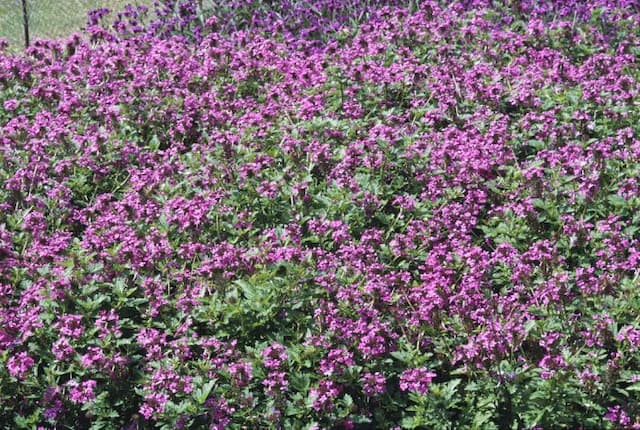
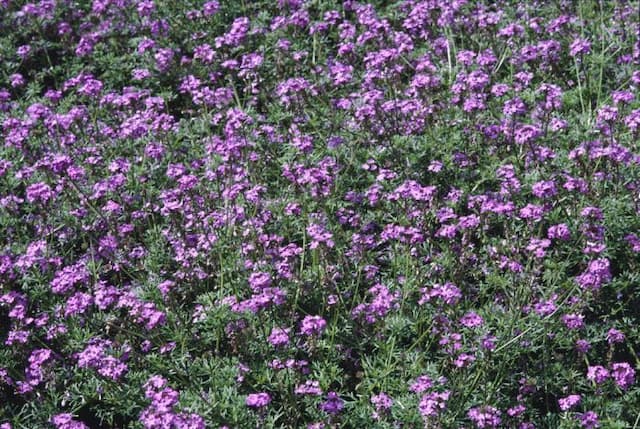
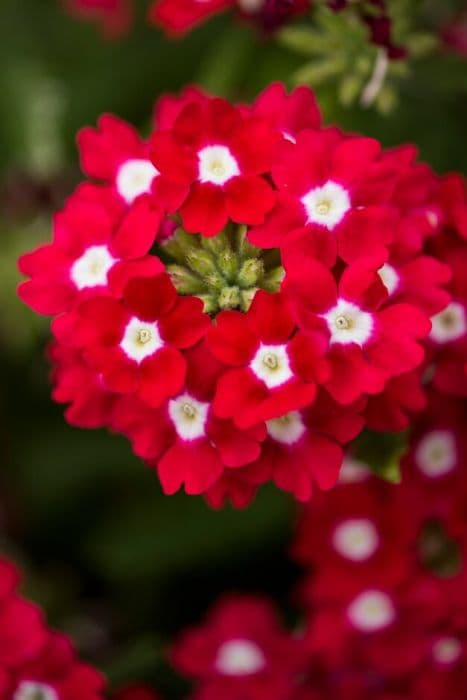
![Vervain [Seabrook's Lavender]](/_next/image?url=https%3A%2F%2Fplants-admin.emdemapps.com%2Fimages%2Fplants%2F%2Fimages%2F604b650ea9729.png&w=640&q=75)

